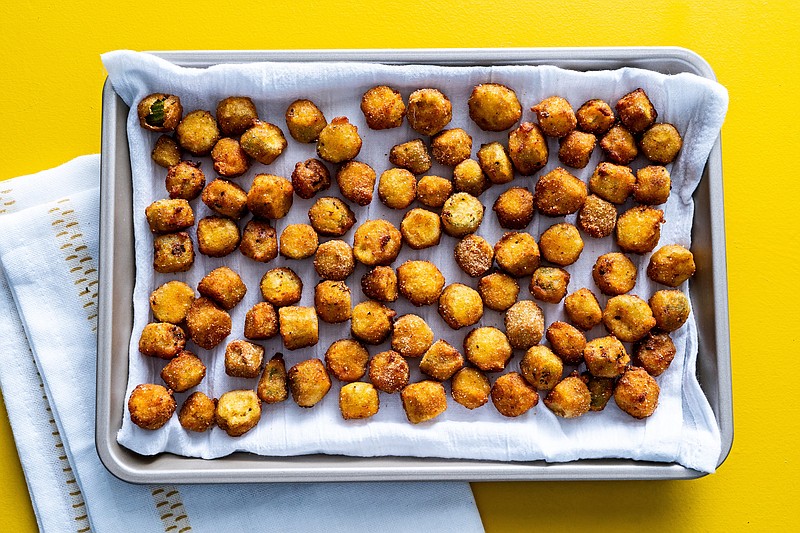The recipe comes from "Jubilee: Recipes from Two Centuries of African American Cooking," in which author Toni Tipton-Martin uses the fried okra as a topping for a bright, lemony salad. I found it was superb enough to stand on its own as an appetizer, side or snack. Tipton-Martin, now the editor of Cook's Country, in turn adapted the recipe from Virginia Mixson Geraty's 1992 book, "Bittle en' T'ing': Gullah cooking with Maum Chrish,'" a cookbook in English and Gullah featuring a fictional cook based on a real person.
Okra's ubiquity in Southern cuisine is inextricably tied to the dark history of slavery. In "The Cooking Gene," culinary historian Michael Twitty says that okra was among an array of crops that first arrived in the Caribbean and South America on slave ships, along with bananas, watermelon, yams and more.
Okra's inherently slimy texture, or mucilage, has long been valued as a thickener in soups and stews, especially gumbo. But that characteristic has its detractors. Frying small pieces goes a long way to eliminating the hurdle. As to how the particular preparation came about, an entry in the University of South Carolina's American Heritage Vegetables project says, "Most parts of the country in the mid-19th century enjoyed a fritter boom, with various fruits and vegetables fried, coated with batter, in lard or some other fat. Fried okra and okra fritters became a fixture of the post-Civil War culinary scene." Now it's seen as a staple of Southern food.
A spicy dip, especially a mayo-based one, would be a fantastic pairing with the fried okra. But I ate them with nothing more than a sprinkle of kosher salt and a smile on my face. It was enough.
This recipe halves easily, though you will still want to use the same amount of oil for the proper depth.
Extra-Crispy Fried Okra
- 1 ½ cups cornmeal
- 6 tablespoons all-purpose flour
- ¾ teaspoon fine salt
- ¾ teaspoon garlic powder
- ¾ teaspoon ground black pepper
- ¾ teaspoon ground red (cayenne) pepper
- 1 pound fresh okra, trimmed and cut into ½-inch slices
- 2 cups buttermilk (regular or low-fat)
- 4 cups vegetable or peanut oil (see notes)
Line a platter or baking sheet with paper towels or kitchen towels and place it near the stove.
Have two large, rimmed baking sheets ready.
In a shallow dish, such as a pie plate, whisk together the cornmeal, flour, salt, garlic powder, black pepper and cayenne.
In a large bowl, carefully toss the okra with the buttermilk, ensuring the pieces are all coated.
Working in batches, use a slotted spoon to remove the okra from the buttermilk, allowing the excess buttermilk to drain. Drop the okra into the cornmeal mixture and spoon the dry ingredients over the okra to coat thoroughly. Rolling the pieces around in the cornmeal mixture also helps ensure an even coating. Transfer the coated okra to a baking sheet (you'll likely need both to avoid overcrowding), shaking off any excess breading. Every so often, rub off any breading stuck to your fingers to avoid ruining the coating on the pieces as you pick them up.
To fry on the stove top:
Partway through coating the okra, pour the oil into a large Dutch oven or other high-sided pot and set it over medium-high heat. Continue to heat the oil to 350 degrees, monitoring with an instant-read thermometer. The oil will take a while to heat up, so you can continue to coat the okra while it warms, but monitor it closely.
Working in batches (10 to 12 okra pieces is a manageable number), gently lower the coated okra into the hot oil with a metal slotted spoon or spider. Cook until dark golden brown and crispy, about 2 minutes, stirring and flipping the okra almost constantly for even browning. You may get some splattering initially, but it should subside after a minute — use a splatter screen as needed. With the slotted spoon or spider, transfer the okra to the prepared platter or baking sheet. Season to taste with kosher salt.
You may need to adjust the heat to maintain the oil temperature, but anywhere from 325 to 360 degrees is acceptable, so don't worry too much about hitting exactly 350.
To prepare in an air fryer:
Heat the machine to 400 degrees. Coat the okra as directed in the recipe, then spray the pieces generously with cooking oil spray and cook in batches for about 10 minutes each, or until crisp and golden brown, shaking and coating again with the spray halfway through.
Let the okra cool for a few minutes, as it's very hot fresh out of the oil, and serve.
Makes about 7 cups.
Note: To reuse the frying oil, let it cool completely. Strain through a fine-mesh strainer lined with a paper coffee filter or cheesecloth to remove any solids, and transfer to a lidded container. Store in a cool, dark place. Assuming you strain well and don't burn the oil, you should be able to reuse it several times.
